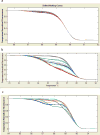Targeted genome engineering techniques in Drosophila
- PMID: 24412316
- PMCID: PMC4048800
- DOI: 10.1016/j.ymeth.2013.12.002
Targeted genome engineering techniques in Drosophila
Abstract
For a century, Drosophila has been a favored organism for genetic research. However, the array of materials and methods available to the Drosophila worker has expanded dramatically in the last decade. The most common gene targeting tools, zinc finger nucleases, TALENs, and RNA-guided CRISPR/Cas9, have all been adapted for use in Drosophila, both for simple mutagenesis and for gene editing via homologous recombination. For each tool, there exist a number of web sites, design applications, and delivery methods. The successful application of any of these tools also requires an understanding of methods for detecting successful genome modifications. This article provides an overview of the available gene targeting tools and their application in Drosophila. In lieu of simply providing a protocol for gene targeting, we direct the researcher to resources that will allow access to the latest research in this rapidly evolving field.
Keywords: CRISPR; Drosophila; Gene targeting; Homologous recombination; NHEJ; Nuclease; TALEN; Zinc finger nuclease.
Copyright © 2014 Elsevier Inc. All rights reserved.
Figures





References
Publication types
MeSH terms
Grants and funding
LinkOut - more resources
Full Text Sources
Other Literature Sources
Molecular Biology Databases

